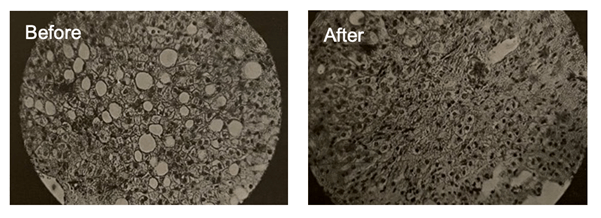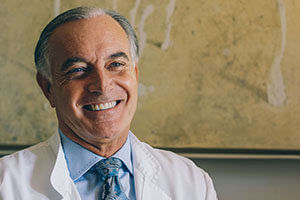REBOOTING THE BODY – A FASTING EXPERIENCE
Stéphane’s journey from fatty liver to lasting health in 21 days
In early 2025, fasting rose to the forefront of both scientific inquiry and public debate, thanks in large part to the documentary “Fasting: Investigating a Phenomenon” by Sylvie Gilman and Thierry de Lestrade. This film introduces us to Stéphane, a Frenchman who sought help at the Buchinger Wilhelmi clinic in Überlingen for metabolic syndrome, a condition marked by obesity and non-alcoholic fatty liver disease. Stéphane’s courageous decision to undergo a 21-day fast offers a compelling case study: His journey shows that, under medical supervision, fasting can be a powerful tool for reversing complex metabolic disorders.
Metabolic normalisation following long-term fasting
Stéphane’s transformation is much more than a story of weight loss – it is a tale of profound metabolic renewal. His laboratory tests provide clear evidence of how his body responded to the 21-day fast:
Stéphane’s weight loss during his stay

From fatty liver to full recovery: The power of fasting
When Stéphane first presented at the clinic, his diagnosis was non-alcoholic fatty liver disease – a condition that affects nearly one in three people and often leads to severe complications if left unchecked. Early intervention is essential, and fasting offers a promising, non-invasive strategy for halting its progression. To assess the severity of Stéphane’s condition, a Fibroscan examination was performed. This non-invasive test uses ultrasound technology to measure both the amount of fat in the liver and its stiffness (a marker for scarring).
Controlled attenuation parameter (CAP):
Stéphane’s initial CAP was 307 dB/m, indicating advanced fatty liver disease (steatosis hepatis S3, with 66% to 100% of the liver affected). After fasting for 21 days, his CAP fell to 242 dB/m, which is within the normal range (under 248 dB/m) and shows that his liver fat was significantly reduced.

These clinical improvements are in line with our own research findings. In our study, even shorter fasting periods (8.5 days on average) were shown to significantly lower the fatty liver index (FLI) – a key marker for liver health. Remarkably, each additional day of fasting increases the likelihood of shifting from a high-risk category to a lower-risk one by 40%. Historical evidence, including liver biopsies from the 1970s, supports the assertion that fasting can visibly reverse fat deposition in the liver.

Photo of liver biopsies before and after long-term fasting showing the elimination of accumulated fat (white spheres) from Zimmermann, W., Phys Med Rehabil, 1972, 13: 94-100
One year later: Did the effects of fasting persist?
Stéphane’s journey is particularly inspiring because the improvements he made were not just temporary. One year after his intensive 21-day fast, he still felt the benefits:
- Sustained blood sugar and blood pressure improvements:
His HbA1c settled at around 5.8%, and his fasting blood glucose remained at a healthy level of 98 mg/dL. His blood pressure, while slightly higher than immediately after fasting was still significantly reduced (135/85 mmHg compared to the original 146/90 mmHg). - Long-term weight loss and waist reduction:
Stéphane’s weight stabilized at 90.4 kg and his waist circumference improved further to 108 cm. These numbers represent more than just a physical change – they indicate a lasting, healthier metabolism and a reduced risk of chronic disease.
Stéphane’s story encapsulates the transformative potential of a medically supervised fasting program. Buchinger Wilhelmi is not just about losing weight temporarily, but about giving the body the opportunity to reset, regenerate and become healthy again from the inside out. If you have 14 days, there is hardly a better way to dramatically improve your general well-being.
Stéphane’s journey is both inspirational and provides us with evidence that done correctly and supported by expert care, fasting can be a catalyst for achieving lasting health improvements. Your body has the power to heal. Sometimes, all it takes is the opportunity to harness your natural resilience.
Answers & questions
During the presentation of the documentary at our clinic, the audience had the chance to ask questions. We are happy to answer some of them below:
What is the best duration for intermittent fasting? Is it better to fast for 12 hours, 14 hours, or 16 hours?
It varies depending on your goals and health, but prolonged nocturnal fasting is a basic requirement for a healthy lifestyle. There is scientific evidence that fasting for 16 hours every day has metabolic benefits, but there is no conclusive evidence on the ideal fasting window.
Is it better to skip lunch or dinner?
It is better to have an early dinner to ensure you get a good sleep and respect your circadian rhythms. Skipping breakfast might not be advisable depending on your health, as this is an important nutritious meal, but if you have a condition like metabolic syndrome or prediabetes, it can be a therapeutic option. It is best to explore these options together with a health professional.
What is the therapeutic effect of fasting on cancer?
Fasting is not a recognised therapy for cancer. Some research suggests that fasting could reduce the side effects of cancer treatments and make them more effective. However, the results from these studies have not yet been implemented in clinical practice as more research is needed to sufficiently guarantee its effectiveness and safety for patients. Our scientific team is working on the topic.
This might also interest you:








